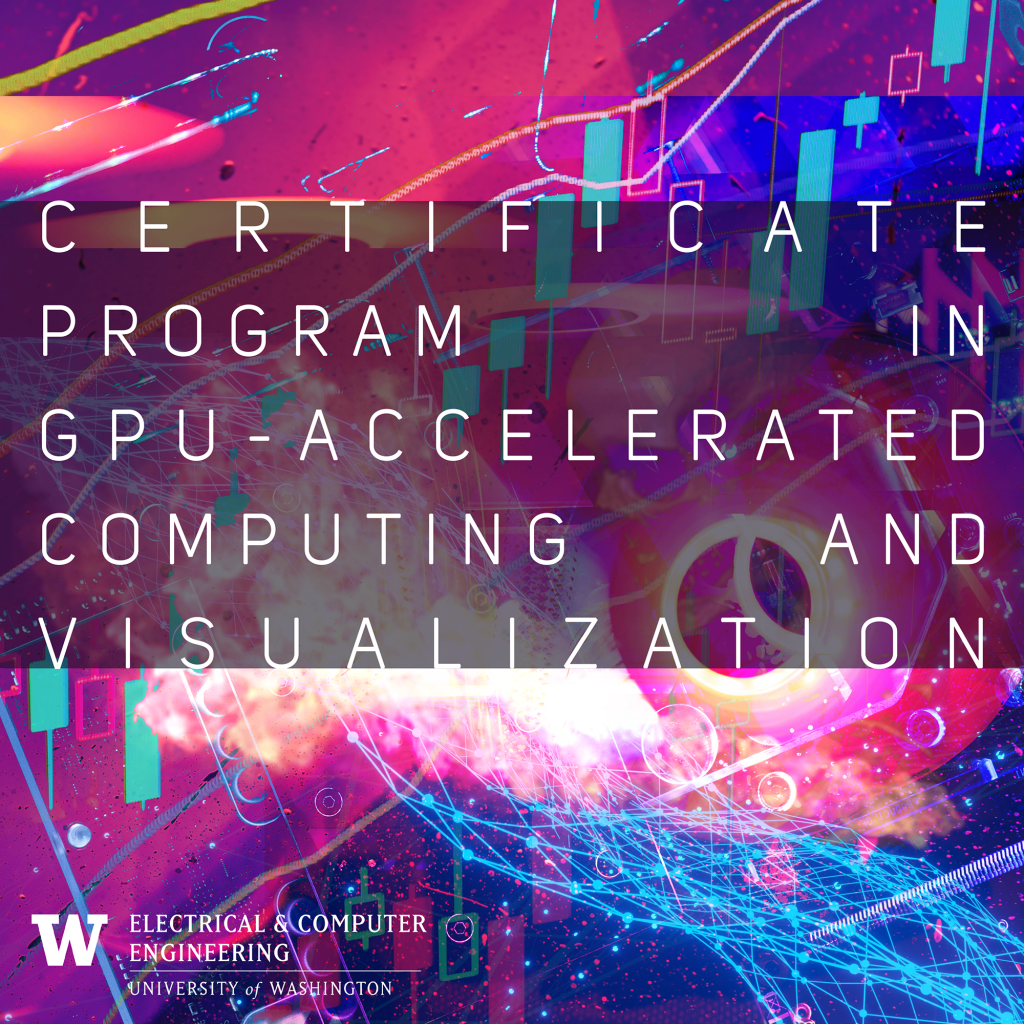
Learn more about the program in this spotlight article!
Certificate Program in GPU-Accelerated Computing & Visualization (ONLINE)
The Graphics Processing Unit, or GPU, is an enormously impactful computing substrate that has a wide range of applications including machine learning and artificial intelligence, robotics, scientific computing, simulation, physical modeling, computer graphics, scientific visualization, gaming, finance, and more. In today’s globally cloud‐connected world, the new problem is too much data. How can we make sense of all the tera/peta‐bytes of data available at our fingertips? How do we extract useful information from the vast raw data? In many fields of engineering, medicine, and scientific research, GPUs and interactive multidimensional computer visualization techniques can provide crucial insight. Scientific data visualization (SciVis) is a hybrid field at the cutting‐edge intersection of real‐time interactive computer graphics, parallel software algorithms, and high‐performance heterogeneous and GPU parallel computing hardware architectures.
In this hands-on, project-based certificate program, we’ll explore how GPU Computing and Scientific Visualization support reshaping and reenvisioning the world in novel dimensions. In a series of three online complementary classes, you’ll learn and apply the theory, practical hands-on skills, and undocumented “black art” techniques required to develop optimized parallel GPU software. We’ll explore in-depth case studies of parallel GPU compute codes and data visualization including machine learning on GPUs (GPU-MPCNN “ConvNets” Deep Learning), biomedical applications, and computational fluid dynamics (CFD). We’ll utilize the latest highly-parallelized GPU graphics and compute APIs including NVIDIA CUDA and OpenGL, along with the Microsoft Visual Studio integrated development environment (IDE) and NVIDIA software tools.
Admissions
This certificate program is designed for working professionals in science, engineering, and software industries interested in developing their skills in optimized parallel GPU software design and programming, with applications in machine learning, scientific/engineering and numerical computing, biomedical, computer graphics, and scientific visualization.
See Admissions Requirements
What You’ll Learn
- GPU kernel function design and coding, debugging, profiling, performance analysis, memory and cache optimization
- Basic parallel-GPU algorithms & data structures, parallel design patterns, linear algebra and matrix computations (for example parallelized FFTs, convolutions)
- Scalar, vector, and volumetric visualization techniques
- Fundamentals of developing interactive 3D visualization tools for a variety of applications which generate large‐scale complex multidimensional datasets
- Techniques to program optimized SciVis algorithms using the parallelized GPU graphics pipeline (OpenGL) and compute kernel shaders
Curriculum
Autumn: Applied High-Performance GPU Computing
Winter: GPU-Accelerated Interactive Scientific Visualization Techniques (SciVis)
Spring: Advanced GPU Computing and Visualization
To successfully complete the certificate, students must complete three classes related to the certificate, with total credits equaling 12. A minimum of 2.7 is required in each course that is counted toward the certificate.
Earn Graduate Credit
By completing this certificate program, you can earn up to 12 credits toward degree requirements should you later be accepted into the Professional Master’s Program. To use these credits, you must obtain graduate non-matriculated status before you register for the first course of the certificate program.
See Tuition & Fees Information
Get Hands-on Experience
The certificate’s project-based courses utilize the latest highly-parallelized graphics and compute APIs such as Khronos OpenGL and NVIDIA CUDA standards.
Technology Requirements
Students in ECE certificate programs are expected to adhere to the College of Engineering’s technology expectations. Students in this certificate will not need to provide their own GPU hardware, and will have access to AWS Appstream virtual desktop development environments.
Certificate Instructor

Courses in the certificate are taught by Colin Reinhardt, an affiliate assistant professor in the Department of Electrical & Computer Engineering at the University of Washington, and an engineer at SPAWAR. His research areas include physically-based rendering, scientific visualization, GPU computing, CUDA and OpenCL, OpenGL, modeling & simulation, predictive rendering, atmospheric propagation, machine learning and neural networks, electro-optics, turbulence theory, scattering theory, radiative transfer, wave propagation in random media, communications, imaging, and stochastic process theory.

